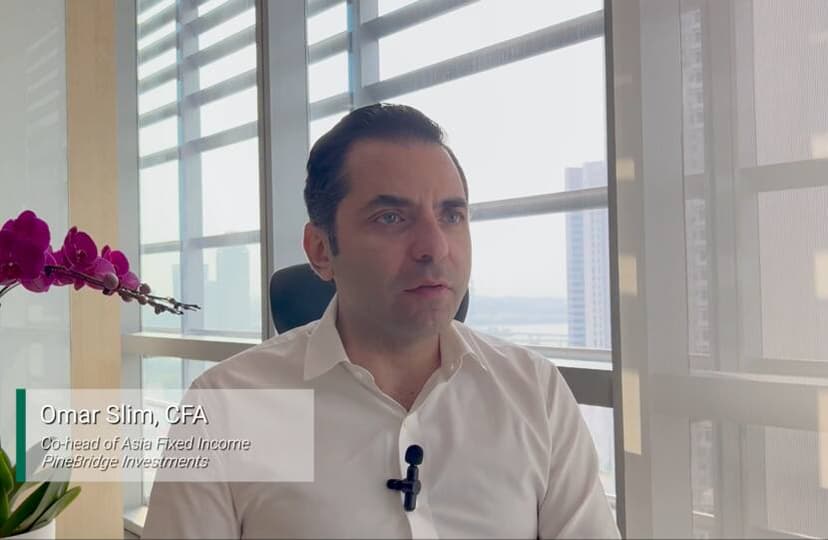Asia Credits Should Stay Resilient in a New US Tariff Regime

Andy Suen, CFA, FRM
Co-Head of Asia Fixed Income

Omar Slim, CFA
Co-Head of Asia Fixed Income

Samsara Wang
Asian Sovereign Analyst

Fan Zhang, CFA
Portfolio Manager & Credit Analyst, Fixed Income

The re-election of Donald Trump as president of the United States has significant implications for Asian economies. Trump's first term was marked by policies that profoundly affected global trade, particularly in Asia. As his second term begins, the region may face more economic turbulence. However, we expect the impact on Asia’s credit markets to be minimal, with effects primarily felt in other asset classes.
While financial markets may experience volatility as more details of Trump's policies are revealed, we generally view movements in credit spreads as opportunities for active investors. Here we summarize the findings from our top-down and bottom-up analysis of the potential tariff implications.
Top-down: gauging the tariffs’ macro impact
One of the most consequential expectations of Trump 2.0 is the reinstatement and expansion of his aggressive trade policies, including a potential 60% tariff on goods imported from China and a 10% tariff on all goods imported from the rest of the world. In Trump’s first term, it took him one year to impose the first batch of tariffs on China. We believe it could happen faster this time. Back in 2017, Trump withdrew the US from the Trans-Pacific Partnership (TPP). His return to office also raises questions about the future of other regional trade agreements. The uncertainty surrounding US trade policies can lead to weaker sentiment in both public and private sectors and hence lower capital expenditures. Asian countries may need to strengthen intra-regional trade ties and seek new partnerships to counterbalance the Trump administration’s potential isolationist policies.
Against this backdrop, we have classified Asian countries based on our assessment of 1) their trade linkages with the US and China, to assess their sensitivity to potential tariffs and a potential China slowdown scenario; 2) their exposure to specific sectors; and 3) whether they could be benefit from supply chain diversification away from China (see charts below).
Asia Has Varied Levels of Exports to the US and China
Export/nominal GDP

Source: Bloomberg, Macrobond, as of 31 December 2023.
US Trade Policy Will Have a Mixed Impact in Asia

Source: PineBridge Investments, as of 3 January 2025.
Bottom-up: assessing US trade implications for individual companies
Our analysis of issuers in Asia’s credit markets revealed that only a limited number will be directly affected by expected tariffs. This finding aligns with the observation that Asia credit spreads have been resilient amid US election-related headlines over the past year. We estimate that only 2.5% of issuers in the JP Morgan Asia Credit (JACI) Index derive over 10% of their revenue from the US and may feel a direct impact. These issuers are mainly in the industrial, consumer, and TMT (telecommunications, media, and technology) sectors in China, Taiwan, Korea, and India.
Asia Credit Has Limited Exposure to US Revenue

Source: J.P. Morgan JACI Composite Total Return Index as of 31 October 2024. For illustrative purposes only. Any opinions, projections, forecasts, or forward-looking statements presented are valid only as of the date indicated and are subject to change. Diversification does not necessarily ensure against market loss. Past performance, or any prediction, projection, or forecast, is not indicative of future performance.
Yet even within this subset of issuers, many have mitigating factors or measures in place to manage the potential tariff impact. For example, Korean automakers already have a high level of production in the US, and the percentage of US revenue produced in Korea is minimal. Taiwanese tech companies have been building factories in the US and Europe and plan to do more. A Chinese battery maker uses a licensing, royalty, and service model, collaborating with original equipment manufacturers (OEMs) in the US to build capacity and charge royalty fees. In some cases, the fundamental impact on the issuer is mitigated by its technological leadership, with products that enjoy strong demand and are hard to replace. Additionally, select issuers in Southeast Asia and India could benefit from supply chain shifts in the region.
We are also mindful of the secondary effects from slower economic growth and incorporate our top-down assessments into our bottom-up analysis. That said, we expect Asia credit issuers to stay resilient on the whole, with strong balance sheets and improving access to cheaper funding both locally and internationally. Notably, Asia investment grade (IG) corporate leverage has remained steady and is lower than that in developed markets, while Asia high yield (HY) default rates continue to trend down.
Asia IG Corporate Leverage Remains Steady and Lower Than for Developed Markets
Comparison of corporate net leverage (IG)

Source: J.P. Morgan, Bloomberg Finance L.P., S&P Capital IQ, and PineBridge Investments as of 30 September 2024. “LTM” stands for “Last Twelve Months”. US and EU data are as of Q2 2024, while Asia data are based on partial Q3 2024 earnings (180+ companies) blended with earlier results for those that did not report.
Asia (ex China Property) HY Corporate Default Rates are Likely to Remain Low

Source: J.P. Morgan and PineBridge Investments as of 29 November 2024. For illustrative purposes only. Any opinions, projections, forecasts, or forward-looking statements presented are valid only as of the date indicated and are subject to change. Diversification does not necessarily ensure against market loss. Past performance, or any prediction, projection, or forecast, is not indicative of future performance.
All told, we believe that while the new Trump administration’s trade stance will create uncertainty and volatility within Asia’s economy, the region’s credit markets should be able to withstand the turbulence.
Disclosure
Investing involves risk, including possible loss of principal. The information presented herein is for illustrative purposes only and should not be considered reflective of any particular security, strategy, or investment product. It represents a general assessment of the markets at a specific time and is not a guarantee of future performance results or market movement. This material does not constitute investment, financial, legal, tax, or other advice; investment research or a product of any research department; an offer to sell, or the solicitation of an offer to purchase any security or interest in a fund; or a recommendation for any investment product or strategy. PineBridge Investments is not soliciting or recommending any action based on information in this document. Any opinions, projections, or forward-looking statements expressed herein are solely those of the author, may differ from the views or opinions expressed by other areas of PineBridge Investments, and are only for general informational purposes as of the date indicated. Views may be based on third-party data that has not been independently verified. PineBridge Investments does not approve of or endorse any republication of this material. You are solely responsible for deciding whether any investment product or strategy is appropriate for you based upon your investment goals, financial situation and tolerance for risk.


